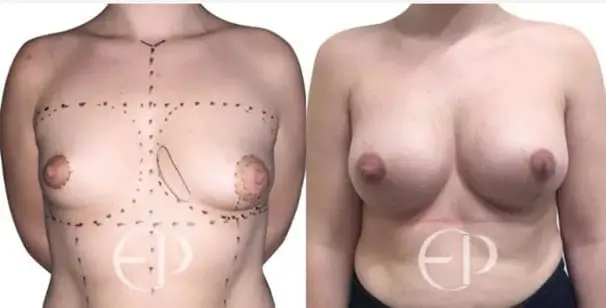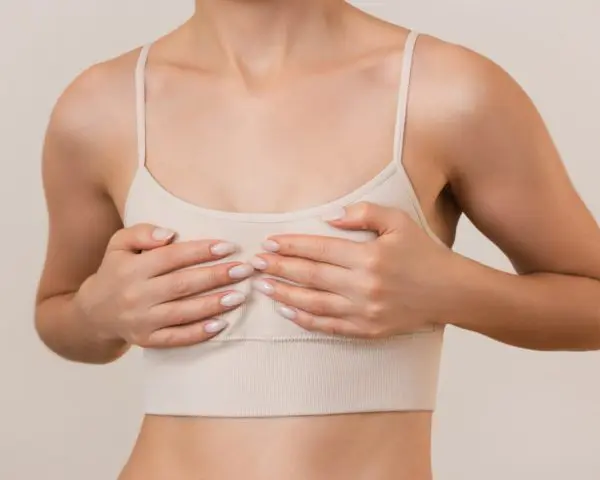There is not any single approach for fixing your tuberous breasts, even the diagnosis of the condition is not clear-cut. Features of the tubular breast condition include conic breast shape, breast hypoplasia (underdevelopment), herniation of the nipple-areolar complex (NAC), a small breast base, and breast asymmetry. Check whether you’re eligible for a tuberous breast correction.
Each feature mentioned above required a unique surgical approach to correct so it’s important to understand the type of procedure you need. Herniated areolas can be fixed using a nipple reduction procedure, but this may not be necessary for every patient with tuberous breasts. We discuss when areola correction is necessary and how it’s performed. We also cover alternatives to breast augmentation as well as how to choose the right procedure.
Click on one of the links to jump to that section
-
Do you need areola surgery for tuberous breast correction?
Learn about which types of tuberous breasts usually require areola reduction
-
How are the areolas reduced during tuberous breast surgery?
Discover how a surgeon can leave aesthetic results while changing the areola size
-
Fixing mild tuberous breasts without implants
Do you have mild tuberous breasts? You may not need complex surgery or breast implants
-
Should you choose an areola reduction surgery?
When should you get nipple surgery, speak with a specialist in tuberous breast correction
- Frequently Asked Questions
Do you need areola surgery for tuberous breast correction?
Tuberous breast deformities are relatively rare and can occur in varying degrees of severity. There are five types of tubular breast conditions that are diagnosed symptomatically. You may not display all the characteristics of one type. However, some types may be more likely to need an areola correction:
Type 0: is a mild tubular breast deformity where your breast base is normal, but you have a herniated nipple-areolar complex. This can look like, large, bulging, or asymmetrical areolas. In this case, you may only want an areola correction.
Type I: There is usually minimal NAC herniation but if the areolas are asymmetrical, you may want an areola correction.
Type II: Nipple herniation and asymmetry are more common in type II breasts. You may need an areola correction and other procedures to correct mild-moderate symptoms.
Type III: most patients with type III tuberous breasts have complaints about areola size and shape. A correction is usually necessary for moderate-severe tuberous breast symptoms.
Type IV: the small breast base that characterises type IV breasts is usually accompanied by nipple-areola herniation/deformity which can only be corrected surgically.
Types III, IV and 0 will likely need some sort of areola correction while types I and II will be assessed on a case-by-case basis.
Do you have large, bulging or asymmetrical areolas?
Ask a plastic surgeon about nipple correction options.
How are the areolas reduced during tuberous breast correction surgery?
One of the most common concerns with breast surgeries, particularly tuberous breast correction is the appearance of scars after cosmetic surgery. Most patients think they will have conspicuous scars after an areola reduction but a skilled surgeon – such as Elena Prousskaia – will leave a subtle mark that blends into the perimeter of the areola.

During an areola reduction procedure, a round-block incision is made around the areola. Any excess breast tissue is removed to correct pointing or bulging nipples. Then a doughnut of skin is removed from the areola to reduce its size. This procedure can be done on one or both breasts to correct breast shape size and asymmetry.
Fixing mild tuberous breasts without implants
Most patients with tuberous breasts display underdevelopment or asymmetry. Tuberous breast augmentation is the best way of addressing these concerns. However, some options don’t involve breast implants for a more natural-looking tuberous breast correction.
-
Areola reduction: if you have type 0 tuberous breasts, you may only need an areola reduction or correction which avoids breast implant surgery.
-
Breast Lift: if you’re happy with your breast size but want a tuberous breast correction and uplift you may not need breast implant surgery at all.
-
Breast reduction: If your breasts are large and a breast reduction can fix asymmetry, you may not need breast implants. Male breast reduction is also available for gynaecomastia.
-
Breast reconstruction: with enough breast volume, breast tissue remodelling may be enough to correct your breast shape without the need for breast implants.
Most patients with mild tuberous breasts, may not even notice the condition until it’s pointed out by a specialist surgeon. If you have conic, underdeveloped breasts or large, bulging areolas, you may need a tuberous breast correction. Read about eligibility for tuberous breast correction surgery.
Should you choose areola reduction surgery?
The type of procedure you choose should always be based on the aesthetic outcome you wish to achieve. If you are happy with the appearance of your nipples, your surgeon won’t change them.
If you want to change bulging, oversized or asymmetrical areolas that cause your breasts to look conic, oval or cylindrical then you may want a tuberous nipple correction. If you have other symptoms of tuberous breasts, you may need several procedures – an areola reduction alone cannot change your breast shape.
Frequently Asked Questions
-
There are several techniques for fixing tuberous breasts, the most unique is breast tissue reconstruction – where breast volume is redistributed and breast constriction is released. Other common techniques include breast augmentation, nipple reduction, breast lift and breast reduction.
-
In most cases, your procedures can be performed in one day unless you need tissue expanders. Tissue expanders create space for breast implants and need to be kept in for 2-3 weeks.
-
At your consultation, Elena Prousskaia will assess the features of your breasts and suggest the best approach to achieve your aesthetic goals. You will also learn about the possible risks and the recovery timeline. Elena Prousskaia’s patient-first approach prioritises honesty and comfort and support, right from the start.
-
The right tuberous breast procedure for you is the one that aligns with your aesthetic goals. Implant-free cosmetic breast surgery is possible, just ask a specialist in tuberous breast corrections. You can also address all sorts of concerns such as breast asymmetry, bulging areolas, breast drooping, underdevelopment, or tubular breast shapes.
-
Recovery from tuberous breast surgery takes up to 12 weeks. In the first four weeks, you should limit excursion, especially in the upper body. After four weeks, you should be able to see the results of your surgery and begin gentle lower-body exercises. After 12 weeks, you should be able to return to your usual activity.
Get treated by the best breast surgeon at North Bristol Private Hospital.





